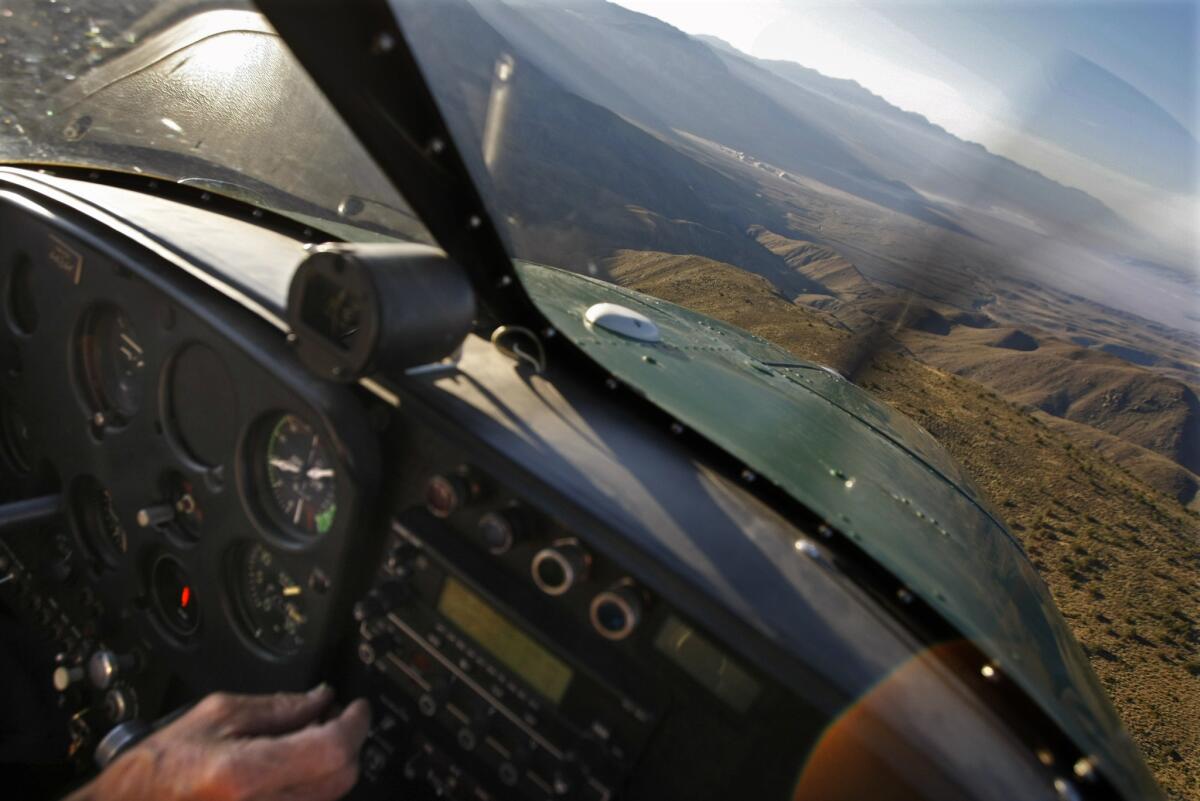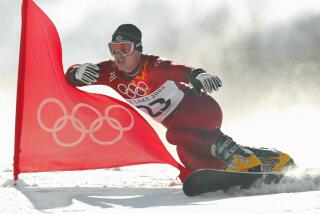Flying high for the Sinaloa drug cartel

- Share via
John Charles Ward would take flight in the half-light before dawn, when he could race down the runway without headlights and ascend into the cloaking embrace of an overcast sky.
Soaring above the crowded California freeways in the single-engine aircraft, he’d relax, pour himself a whiskey and Seven and plan his hopscotch route to Pennsylvania. Inside the plane were 242 pounds of cocaine; outside, nothing but clouds.
“There are no curbs in the sky,” Ward said. “There’s no place for anybody to pull you over.”
Flying shipments for the Sinaloa drug cartel was Ward’s best gig in years. No street dealing, packaging or other grubby chores required. He delivered cocaine to a distributor in Pennsylvania and returned with duffel bags stuffed with up to $2.8 million, keeping a few 6-inch stacks of cash for himself.
Taking off from Riverside County’s Corona Municipal Airport at dawn, Ward could be back the next day, feeding twenties and hundreds into the counting machine at his home in Carlsbad.
Still, he had some nagging concerns. The Mexican distributors in Pennsylvania were trying to cut costs by hiring immigrant truckers to haul drugs from Southern California. And U.S. agents were keeping a close watch on traffickers in the historic towns of Lancaster County, Pa., a distribution hub.
Ward was an expert at covering his tracks. He usually stayed at a cottage-style motel just off the runway at Smoketown Airport, the self-described “Gateway to Pennsylvania’s Amish Country.” After midnight he donned black clothing and lugged cocaine-filled gym bags from the plane to his room. He avoided people, paid cash for most purchases and, if anybody asked, said he was an aircraft broker.
“The money never stopped. The product never stopped,” he said. “Everything was moving continuously.”
Veteran of the trade
By the time President Nixon declared the “war on drugs” in 1971, Ward had been transporting dope to California for years. He grew weed at a farm he owned in Missouri and shipped it by truck. A few years later, responding to demand for better pot, he partnered with marijuana farmers in Mexican villages and hired pilots — some of them Vietnam War veterans — to fly the drugs across the border.
But they were unreliable prima donnas. So he decided to get a pilot’s license. He went to Hawaii to train in crosswinds, headwinds and on island hops.
“I said to myself: ‘I’m going to be the best smuggler there is. I’m going to be the one without an attitude,’ ” Ward said.
Over three decades, he piloted more than 50 planes, from cramped Beechcraft Musketeer three-seaters to an Aero Commander 500 that he’d jam with 1,500 pounds of marijuana. In the 1970s and ‘80s, he made short trips to northern Mexico, landing on runways marked by burning tires, and made long flights through the Sierra Madre, where joyous farmers rode alongside his plane on horseback, shooting pistols into the air.
Ward was scrappy and resourceful, an adrenaline junkie with a taste for the finer things. His smuggling paid for a desert estate, a sailboat named Romancing and Dom Perignon-fueled parties. He relished the challenges of aerial smuggling and devised ingenious ways to avoid detection.
He’d fly across the border skimming treetops to evade radar. He’d land in the desert, at improvised airstrips where his crews laid generator-powered runway lights. For engine troubles, he packed a tool bag with fuses and wrenches. For human problems, he tucked a 9-millimeter handgun in his waistband.
One step ahead
Federal authorities, who had been aware of Ward’s air smuggling since 1975, chased him in the desert sky, bugged his phones and planted tracking devices on his aircraft, some of which he found and kept behind his bar at home to show off to his drinking buddies.
In 1981, customs agents seized three of his planes at airports in Riverside County. He was convicted of drug conspiracy charges as the leader of 13 pilots and ground crew members. He served four years of an eight-year sentence, and took to the skies again.
In 1990, federal agents saw Ward’s plane touch down on a landing strip near Death Valley. The ground crew unloaded 500 pounds of marijuana, and Ward flew off into the night. A government pilot gave chase with his lights out but lost him. Agents found the plane later at Banning Municipal Airport. The belly was coated with dirt, the engine still hot. But Ward was gone.
The agents caught his crew members, who fingered Ward. He faced conspiracy charges in that case and another in Riverside County. He was looking at up to 10 years in prison if convicted.
His attorney, Tom George Kontos, a former federal prosecutor from Los Angeles, negotiated a plea agreement that resulted in a year’s house arrest.
Ward was forever grateful to the sharp-dressing attorney who he said was skilled at swaying judges. “He could charm the birds out of the trees,” Ward said.
Kontos and Ward became close friends, attending each other’s weddings and investing in a used-car business. Ward referred several traffickers to Kontos; Kontos sold Ward his house in Carlsbad, paid for with drug money.
Ward named his second son after Kontos. “He described me as the brother he never had,” Ward said. “He was my hero.”
‘Pouring concrete’
Ward and his wife lived in a large, two-story home that backed onto an ocean-fed lagoon in Carlsbad. Neighbors would see him tinkering in his garage where he was designing an airplane-towing device. They rarely got so much as a wave hello, but they figured it was the aloof manner of an eccentric amateur inventor. They had no idea that Ward buried money in his yard or flew drugs across the country.
Ward began flying for the Sinaloa cartel in 2004, teaming with Rafael Dominguez, a racehorse breeder from Riverside County who had connections to drug distributors in Southern California.
When Dominguez had a cocaine load ready for shipment, he’d phone Ward, telling him that he had lined up another job “pouring concrete.”
The cocaine was the best Ward had ever tasted, and was believed to come from a drug distribution network headed by Victor Emilio Cazares, allegedly a top cartel lieutenant in Sinaloa. The bricks were labeled with a scorpion logo.
“It was uncut … a pearly color, flaky, with a candy kind of smell to it,” Ward said. “People would pull your arms off for that stuff.”
Ward could carry nearly 250 pounds of cocaine per flight and he charged $450 per pound, earning about $110,000 per trip, plus $5,000 for expenses.
Truckers, some with spotty records, delivered nearly double that amount for half Ward’s fee.
Ward didn’t like the cost-cutting and careless behavior of the East Coast distributors to whom he delivered the drugs. He’d had words with one of them, Noe Coronado, who cultivated a Culiacan clubster look — pompadour and shiny rayon pants — that stood out in the bluejeans-and-baseball-cap world of Lancaster, Pa.
Ward worried that Coronado’s lack of discretion put them both at risk. Nevertheless, it was hard to resist the tug of another deal. “It wasn’t just a smuggling job. It was my career,” Ward said. “I put a lot of thought into it and tried to see where others made mistakes.”
When Ward got a call about another shipment, he would drop the tools in his garage, pocket his two-way radio and grab his GPS case and overnight bag. At the door, he would kiss his wife goodbye.
“Don’t ask me when I’m coming home. Don’t ask me where I’m going…. I’ll just see you later,” he would say.
Cops down below
Ward always arrived before dawn at Corona Municipal Airport, a dusty compound with a diner and flight school and a double-wide trailer for a manager’s office.
He and Dominguez would drive to the plane and throw the duffel bags in the tail-section storage compartment. About 15 minutes before dawn, Ward lifted off alone over the office parks and turned east.
The 1992 Socata, a French-made aircraft, had a cruising speed of 200 mph and an 800-mile range, which meant four refueling stops. Down below, Ward saw highway checkpoints crawling with cops. High above, he could have a drink, maybe smoke a joint or watch some porn on his laptop.
Flying below 18,000 feet he didn’t need a flight plan. Most of the airports where he stopped were sleepy municipal or mom-and-pop operations.
Still, Ward didn’t take any chances. After taxiing to a refueling stop, he ran through the maintenance checklist like a one-man Nascar pit crew.
“There’s not one second wasted,” he said. “When you land, you break out your computer as you’re gassing your airplane. Getting the weather, you get the quart of oil … grab it, stick it in … throw away the spout, wipe your hands [and] jump in the airplane.”
By dusk, he could see the green rolling hills and farmland of southern Pennsylvania. He typically landed at Smoketown, but fearing excessive use would draw attention, he had started using airports in York and Carlisle, both within 60 miles of Lancaster.
Ward had lectured Coronado about his loud clothing. He criticized him once for failing to use the turn signal on their way to dinner and for not keeping his DMV documents current.
Coronado resented Ward’s bossy attitude, but Ward wouldn’t back down. “I was dressing him and telling him what to do, but I mean it was a disaster,” said Ward. “It’s no way to fly.”
Eventually, the lectures had the desired effect. By the fall of 2006, Coronado had changed his wardrobe, trading his shiny pants for Dockers, and had stopped driving without insurance or with expired registration tags. He had also taken Ward’s advice and started a carpet cleaning business as a front.
But Coronado had continued to work with other, less-expensive suppliers, and their loose talk soon caught up with him.
On Jan. 12, 2007, two men drove down from New York to pick up cocaine that Coronado had received by truck. Tipped to the deal, Drug Enforcement Administration agents followed them and pounced on Coronado after the transaction. The agents found $1.8 million at Coronado’s home.
Facing a potential 20-year prison term, Coronado was pressured to cooperate. He refused to disclose much about his Mexican connections, fearing retaliation against his family. But he was willing to talk about the cocaine shipments he received by air from California.
One morning in June 2007, Ward walked outside in his bathrobe to get the newspaper and was greeted by squads of police and DEA agents.
“Don’t tell these idiots anything!” he yelled to his wife. “These people are not your friends!”
Ward figured Kontos could cut a deal, as he had in the past. But prosecutors, suspecting that Kontos was laundering drug money, had seized 12 of his properties. He pleaded guilty to conspiracy to commit obstruction of justice, received a 21-month sentence and agreed to cooperate.
Kontos revealed that Ward had buried drug money in his backyard. Investigators didn’t find anything there, but they did find $67,500 in a bag of walnuts in the freezer.
Ward pleaded guilty to drug and money-laundering charges and was sentenced to 10 years in prison. The federal government seized his Carlsbad house, the money in the freezer and his Socata aircraft. His partner, Dominguez, also received a 10-year sentence.
Ward’s flying career was over.
Kontos “said he would never represent an informant, and the guy turns out to be one himself,” Ward said.
PHOTOS: Key DEA surveillance images of Ward and Dominguez
Books and a view
Federal inmate 74505-012 at Northern California’s Herlong Correctional Institution works in the kitchen, serving food and sweeping floors. He’s four years into his sentence at the minimum-security facility, which has no perimeter fence and feels more like a camp than a prison.
Ward, 64, roams the large yard, takes algebra classes, reads books on American history and enjoys the views of the Sierra Nevada.
He’s still alive, even after all the close calls of his extreme smuggling years: mechanical failures at 10,000 feet, days stranded in a sweltering desert, encounters with Alaskan bears, Mexican cops, Colombian guerrillas, shotgun-toting thieves and stingy drug lords.
Some days, he has regrets, but not on this day. After all, a few more years in this relatively genteel setting and he’ll be a free man again.
“I’m the absolute luckiest person on Earth,” Ward said. “If you’re going to put your luck against mine, you haven’t got a chance.”
MORE: The players | Evidence, wiretaps and testimony | How the drug pipeline worked | Photos: DEA surveillance
Part One: Unraveling Mexico’s Sinaloa Cartel
Part Two: The drug trafficker and the psychic
Part Four: Showdown in Sinaloa
About this story
For several years, the U.S. Drug Enforcement Administration put the distribution side of Mexico’s Sinaloa cartel under a microscope. This series describes the detailed picture that emerged of how the cartel moves drugs into Southern California and across the United States. Times staff writer Richard Marosi reviewed hundreds of pages of records, including DEA investigative reports, probable-cause affidavits, and transcripts of court testimony and phone surveillance. He also interviewed DEA agents, prosecutors and local law enforcement officers serving on DEA-led task forces, as well as two cartel operatives convicted in the investigation.
More to Read
Sign up for Essential California
The most important California stories and recommendations in your inbox every morning.
You may occasionally receive promotional content from the Los Angeles Times.











